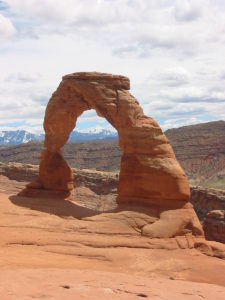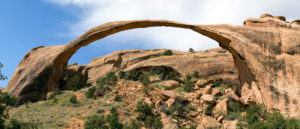Arches National Monument was created by President Herbert Hoover on April 12, 1929. It remained a national monument until 1971, when the U.S. Congress passed and President Richard Nixon signed a law to change the status to a national park.
Arches National Park lies in the east-central Utah, near the city of Moab. Arches is the farthest east and north of the five great national parks in Utah (Canyonlands, Capital Reef, Zion and Bryce Canyon are the others). Among the geological beauty and grandeur of these parks, Arches stands out with more than 2000 arches, the highest concentration of such features anywhere in the world.

A Hungarian immigrant, Alexander Ringhoffer, was the first early proponent of creating a park. He had seen the land first in 1922, naming an area of arches and spires “Devil’s Garden” (now in the northern part of the park). He brought the area to the attention of the nearby railroad, convinced that advertising the uniqueness and raw beauty could enhance tourism—and railroad fares. The idea caught on, despite misgivings by some locals who wanted the government land open for mining and grazing.
When President Hoover created Arches National Monument, it included a mere 4,520 acres in two separate tracts. Franklin Roosevelt increased it to 29,000 acres in 1938, and several other expansions led to its current size of about 77,000 acres. The Presidential Proclamation created the park acclaimed that “these areas contain extraordinary examples of wind erosion in the shape of gigantic arches, natural bridges, ‘windows,’ spires, balanced rocks, and other unique wind-worn sandstone formations, the preservation of which is desirable because of their educational and scenic value.”

Hoover was correct—people now flock to Arches and its neighboring national parks. From the 500 people who visited in 1929, annual visitation now is over 1.5 million per year and growing rapidly. Visitation has doubled since 2000. It is particularly attractive because many of the most outstanding geologic features are visible from the road or accessible via easy hikes.
References:
Firmage, Richard A. 2016. Arches National Monument. Utah Historical Quarterly, August 29, 2016. Available at: https://heritage.utah.gov/history/uhg-arches-national-monument. Accessed April 10, 2018.
National Park Service. Arches National Park, Management. Available at: https://www.nps.gov/arch/learn/management/index.htm. Accessed April 10, 2018.
